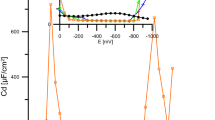Abstract
Coadsorption of 1-adamantanol (AdOH) and halide anions (F–, Cl–, Br–) at the Hg/H2O interface is studied systematically. Experimental results are compared with calculations of these systems within a modified Alekseev–Popov–Kolotyrkin model complemented by a set of two Frumkin isotherms. A satisfactory agreement between experimental data and theoretical conclusions concerning dependences of the phase transition potentials and the adsorption-desorption potentials on the concentrations of supporting electrolyte and organic substances is established. The experimental and calculated potential dependences of the differential capacitance in the phase transition region in the case of the AdOH adsorption from electrolytes containing halide anions are compared. It is shown that the shape of experimental capacitance curves corresponds to either a weak attraction of species of different nature during concurrent adsorption or the absence of lateral interaction between them. Accounting for the contribution made by the energy of the diffuse double layer to the overall energy gain during the adsorption removes seeming contradictions in the interpretation of dependences studied.
Similar content being viewed by others
REFERENCES
Damaskin, B.B. and Baturina, O.A., Elektrokhimiya, 2001, vol. 37, p. 141.
Alekseev, Yu.V., Popov, Yu.A., and Kolotyrkin, Ya.M., Elektrokhimiya, 1976, vol. 12, p. 907.
Damaskin, B.B., J. Electroanal. Chem., 1969, vol. 21, p. 149.
Frumkin, A.N. and Damaskin, B.B., in Modern Aspects of Electrochemistry, Bockris, J.O'M. and Conway, B.E., Eds., London: Butterworths, 1964.
Damaskin, B.B., Survila, A.A., and Rybalka, L.E., Elektrokhimiya, 1967, vol. 3, p. 146.
Baturina, O.A., Damaskin, B.B., Stenina, E.V., and Sviridova, L.N., Elektrokhimiya, 1997, vol. 33, p. 1253.
Damaskin, B.B. and Grafov, B.M., Elektrokhimiya, 1991, vol. 27, p. 1349.
Stenina, E.V., Kolobaeva, N.P., Damaskin, B.B., and Fedorovich, N.V., Elektrokhimiya, 1982, vol. 18, p. 1299.
Clark, J.H. and Miller, J.M., J. Am. Chem. Soc., 1977, vol. 99, p. 498.
Perelygin, I.S., Vodorodnaya svyaz' (The Hydrogen Bond), Moscow: Nauka, 1964, p. 189.
Vargalyuk, V.F. and Loshkarev, Yu.M., Elektrokhimiya, 1978, vol. 14, p. 1421.
Author information
Authors and Affiliations
Rights and permissions
About this article
Cite this article
Stenina, E.V., Baturina, O.A., Sviridova, L.N. et al. Coadsorption of Halide Anions and 1-Adamantanol Molecules on a Mercury Electrode. Russian Journal of Electrochemistry 37, 931–938 (2001). https://doi.org/10.1023/A:1011996210341
Issue Date:
DOI: https://doi.org/10.1023/A:1011996210341



